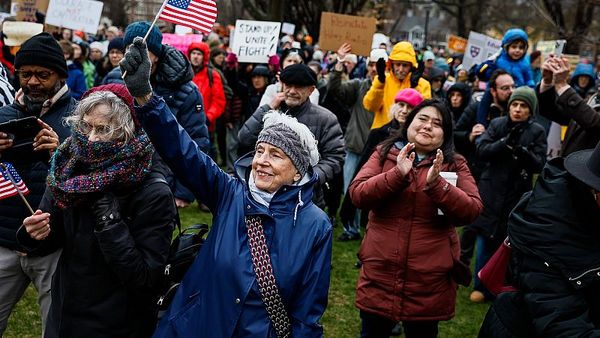WASHINGTON — The lawmakers who wrote this year’s final defense authorization bill deleted or diluted all eight House-passed NDAA provisions pertaining to extremism in the U.S. military or American society.
Most of the discarded provisions that the House included in its initial version of the National Defense Authorization Act merely sought information about the threat posed by groups such as domestic terrorists, criminal gangs and organizations committed to advancing white supremacy or antisemitism.
Of the eight provisions, seven were completely removed from the bill that is expected to become law. The other House-passed provision, which requires a report, was reduced in scope so it would discuss only foreign threats, not homegrown ones.
The final bill added just one section at all related to domestic extremism: a requirement for the director of national intelligence to assess how social media posts are used in screening personnel, including for extremist ties.
The expunging of domestic extremism provisions from the final fiscal 2023 NDAA has not been previously reported. The House passed the bicameral compromise bill Dec. 8, and the Senate could clear it for the president’s signature this week.
The deletions come five months after the Senate Armed Services Committee, in the report accompanying its version of the NDAA, issued nonbinding language calling for an “immediate” halt to Pentagon counter-extremism programs. The danger of extremism in the ranks, the committee said, does not warrant the time and money being spent on training and education to prevent it or root it out.
The Armed Services members from both chambers who wrote the final bill did not repeat that call. But their removal of requirements to collect more information about the problem of hate groups strikes some lawmakers and experts as a sign of congressional resistance to even dealing with ideologies that are pernicious in the military and society at large, even if the adherents are relatively few in number.
Rep. Pete Aguilar of California, the incoming House Democratic Caucus chair and a member of the Defense Appropriations Subcommittee, has been outspoken about the need to protect the military from extremists. Aguilar told CQ Roll Call in a statement that the Armed Services leaders’ removal of the extremism provisions from the final NDAA hurts U.S. national security.
“I am deeply concerned about Republican-led efforts to not only ignore the rise of domestic extremism, which the FBI lists as one of our nation’s most serious threats, but to make it easier for white supremacist groups to infiltrate our military,” Aguilar said. “Sadly, we know that hate groups and violent extremists are actively recruiting veterans and active duty servicemembers, and the removal of language to combat violent domestic extremism runs contrary to the Department of Defense’s stated goals.”
Armed Services oversight
Adam Smith, the Washington state Democrat who chairs the House Armed Services Committee and who was one of the principal negotiators of the final NDAA, did not address the deleted provisions themselves in a statement to CQ Roll Call. But he said the Armed Services panel receives regular updates on efforts by extremist groups to recruit military personnel and on the Pentagon’s efforts to deal with the problem.
“Extremism has no place in our military, and I am a strong proponent of Department of Defense efforts to combat hateful ideologies and extremism in the ranks,” Smith said in the statement.
Senate Armed Services Chairman Jack Reed, D-R.I., and House Armed Services ranking member Mike D. Rogers, R-Ala., did not respond to requests for comment.
Reed voted in July against the amendment in his committee urging an immediate halt to counter-extremism programs.
Rogers has been adamant that the Defense Department’s civilian leaders are too focused on so-called woke pursuits, from countering extremism to welcoming transgender service members. Rogers — who will become House Armed Services chairman in the next Congress — has promised to closely monitor such efforts.
James M. Inhofe of Oklahoma, the top Republican on the Senate Armed Services Committee, told CQ Roll Call by email in July that extremists “have no place in our military,” but added: “We need to balance the size of the problem with the investment we make in dealing with it.” Inhofe is retiring at the end of this year.
Proponents disappointed
The Department of Homeland Security calls domestic extremists the most serious terrorist threat to America, though some Republicans disagree.
Despite the tiny percentage of the active-duty military and the veterans community found to be active in extremist groups, people with military ties are disproportionately represented there, experts say. And, they add, even small numbers of U.S. military or law enforcement personnel in such groups can threaten U.S. security in multiple ways.
Those experts and the House Democrats who wrote the stripped-out provisions worry that the final NDAA reflects the strength of what they consider a politically motivated conservative push to ignore the domestic threat in the military and American society — and a reluctance by Democrats to fight enough to keep the provisions in a bill that can only be cleared with bipartisan support.
Rep. Sheila Jackson Lee, D-Texas, was the author of one of the deleted, House-passed provisions. It required an interagency report led by the Defense secretary on the “nature and extent” of the security threat from domestic terrorists, including, her provision says, “groups motivated by a belief system of white supremacy such as the Proud Boys and Boogaloo.”
In a phone interview, Jackson Lee expressed “disappointment that there may be some hesitation to get the truth.”
“We as a Congress should put aside any thought that it is a personal affront to our constituents or to our beliefs” to ask these questions, and instead should “just look at the issue of the security of the American people,” said Jackson Lee, a member of the Homeland Security and Judiciary committees.
Ryan Greer, a former Department of Homeland Security official who is now the director for national security at the Anti-Defamation League, a civil rights organization, said it is disheartening to see Congress’s reluctance to more thoroughly confront the problem of extremist groups, including their effects on the military.
“That Congress has not taken on the extremist threat at a significant scale is incredibly worrisome,” Greer told CQ Roll Call. “Our national security and the safety of our communities is under threat, and we need action — now.”
Bill Braniff, an Army veteran and director of the University of Maryland National Consortium for the Study of Terrorism and Responses to Terrorism, or START, agreed.
“A ‘small-numbers, high impact’ occurrence like extremism is something that a self-policing profession like our military needs to keep track of — if for no other reason than to know that the problem isn’t widespread or growing,” Braniff said via email. “Given the diversity of our all-volunteer military and the importance of civilian control of the military, it is critical for recruitment, combat effectiveness, and good order and discipline that the institution communicates that it does not tolerate violent extremism in the ranks. It is worrisome if we let hyper-partisanship prevent this institution in particular from maintaining its integrity.”
Threat indicators
“Domestic violent extremism poses the most lethal and persistent terrorism-related threat to our country today,” Homeland Security Secretary Alejandro Mayorkas said earlier this year.
The problem of extremism in the military and among veterans is like espionage, experts say: occurrences are infrequent but dangerous.
The number of extremists in the ranks of current and former servicemembers has grown alarmingly in recent years, databases indicate, as extremist groups have sometimes successfully recruited veterans of the wars in Iraq and Afghanistan:
— In the last decade, an annual average of 24 Americans with military connections were convicted of a crime of violent extremism, even after taking out the Jan. 6 rioters, the START center says. That annual average is four times as high as in the previous decade.
— A 2019 Military Times survey of active-duty U.S. military personnel found that one in three had witnessed examples of white nationalism among fellow service members.
— Nearly one in five people charged in the Jan. 6, 2021 attack on the Capitol had military ties, and the majority of the Proud Boys indicted for seditious conspiracy were veterans.
Harm to the military
On the heels of the Capitol attack, the Pentagon set up a Countering Extremist Activity Working Group to tackle the problem. Over the course of February and March 2021, commanders met with their troops for a day to discuss the issue in what the military calls a “stand down.”
Republicans have depicted those meetings as a distraction from the armed forces’ mission. But such gatherings took an average of two hours per year for each service member, Pentagon data shows.
The impact of extremism in the military and veteran communities is significant beyond its numbers, experts at the Pentagon and in research groups say.
“Even the actions of a few can have an outsized impact on unit cohesion, morale and readiness — and the physical harm some of these activities can engender can undermine the safety of the Total Force,” said the Pentagon’s counter-extremism task force’s December 2021 report.
The harms are felt in physical injuries and deaths, stolen equipment, recruiting losses, as well as degradation of unit cohesion, morale and mission effectiveness, the Anti-Defamation League argued in a Nov. 22 letter to congressional leaders calling for inclusion of the House-passed requirements in the final NDAA.
“The threat of extremism to the armed forces and uniformed services is too important to be left unaddressed,” wrote Max Sevillia, an ADL vice president. “We call upon you to ensure that key anti-extremism provisions passed in the House are included in the final FY2023 NDAA legislation.”
Deleted provisions
The Senate Armed Services Committee’s nonbinding amendment calling for an immediate halt to Defense Department counter-extremism efforts was approved 14-12, with all Democrats voting no and independent Angus King of Maine joining Republicans to clinch its approval.
Though that language was not repeated in the final bill, of the eight House-passed NDAA provisions on domestic extremism, seven were eliminated completely from the final bill.
Four of those seven were dropped with essentially no explanation besides, “The agreement does not include this provision.”
One of those was Jackson Lee’s requirement for a Pentagon-led report to the defense committees on the threat from domestic extremists.
Another was a requirement for a separate Pentagon-led interagency annual report to Congress on antisemitism and violent extremism, including the threat they pose to the U.S. armed forces.
A third ditched requirement would have mandated an interagency report every six months on white supremacists and neo-Nazis in U.S. military and law enforcement and strategies to combat them.
The fourth would require an interagency report on “the processes needed to regularly report to Congress on domestic terrorism threats” and a Government Accountability Office report on agencies’ compliance with laws requiring such reporting.
Three other requirements were completely stripped but, in those cases, an explanation was provided in the explanatory report stating, in essence: this work is already underway.
One of those three would have required the Pentagon to implement recommendations in one of its own reports on greater cooperation with the FBI and other steps to root out extremist influence in the military. Another would require reporting to the defense committees on equal opportunity complaints of antisemitism.
The third would mandate that military personnel records reflect when someone was discharged because of extremism.
Foreign threats only
The only House-passed provision kept in the final bill was significantly altered to avoid dealing with domestic dangers.
It would have required an annual interagency report on the use of social media by foreign terrorist organizations, including “the threat posed to the national security of the United States by the online radicalization of terrorists and violent extremists.”
The final NDAA says the social media report needs to only be produced once and must exclude from its scope any discussion of the effect of such information campaigns on people in the United States.
Ultimately, only one provision at all related to domestic threats was included in the final bill, and it does not appear to have been part of either the House or Senate NDAAs. It would make the director of national intelligence report to Congress on the government’s use of social media posts in vetting personnel and conducting security clearances. The report must include an assessment of policies for handling protest, extremist and gang activities.
Despite the new NDAA’s pullback from their extremism provisions, the authors promised to renew their efforts going forward to enact requirements for more official reporting on the threat, whether in the armed forces and more broadly.
Intelligence and law enforcement authorities “have indicated domestic terrorism is should is and should be a high priority,” Jackson Lee said. “And so I’m gonna try it again.”







